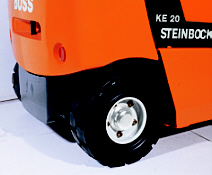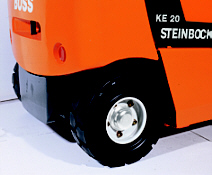
轮胎代表着叉车与其滚动地板之间的连接。它们部分用作减震器,并在叉车和地面之间传递动力。
对叉车制造商和所有者的最重要要求是:
•大容量小直径轮胎
•最小滚动阻力
•坚实的支持
•良好的驾驶舒适性
•轮胎寿命长
•低地面压力,高减震性能,良好的驾驶舒适性。
•特别适用于恶劣和粗糙的表面
•高地面压力和低冲击吸收
•仅适用于牢固的地面
•轮胎轮辋-与充气轮胎相同
•泡沫垫-在压力下填充到充气轮胎的空腔中
•具有合适轮廓的普通充气轮胎。
•不再有flat胎
•无需维护
•特别适合需要高稳定性的场合
•体积小但承载能力高
•卡车的高稳定性
•最小滚动阻力
•低冲击吸收
•最小的驾驶舒适度
•不适合高速行驶
许多不同类型的叉车需要许多不同的轮胎和尺寸。
1)充气轮胎
充气轮胎与汽车中的轮胎相同,安装在轮辋上并充满空气。轮胎的类型取决于所需的容量和所需的尺寸。容量取决于气压和封闭的空气量。
a)低压充气轮胎
b)高压充气轮胎
2)泡沫充气轮胎(也称为超弹性轮胎)
泡沫充气轮胎恰如其名。它是充气轮胎,但不是充气,而是由泡沫填充。它们由以下组件组成:
这些轮胎的使用需要具有足够容量的牢固地面。
优点:
3)实心橡胶轮胎
实心橡胶轮胎-顾名思义-是完全由直接安装在轮辋上的橡胶制成的轮胎。它们几乎不吸收冲击,并且通常没有轮廓。它们具有以下优点:
减震和驾驶舒适性极小。这些轮胎只能在最高10英里的行驶速度下使用。它们可以在有足够容量的坚实地面上使用。
4)聚氨酯轮胎
聚氨酯轮胎(也称为Vulkollan轮胎)是将人造橡胶(聚氨酯)直接固化到钢体上的实心轮胎。由于聚氨酯非常坚韧,因此容量约为橡胶的两倍。聚氨酯轮胎也是无痕轮胎。它们可用于具有光滑洁净地面的室内操作。
缺点:
Tyres represent the connection between the forklift truck and the floor it rolls on. They act partially as shock absorber and transmit the power between the forklift truck and the ground.
The most important requirements for the manufacturers and owners of forklift trucks are:
• high capacity of small diameter tyres
• minimal rolling resistance
• solid support
• good driving comfort
• long tyre life
The many different types of forklift trucks require a number of different tyres and dimensions.
1) Pneumatic Tyres
Pneumatic Tyres - same as found in automobiles - are mounted on a rim and filled with air. The type of the tire depends on the required capacity and the needed size. The capacity is determined by the air pressure and the amount of air enclosed.
a) Low Pressure Pneumatic Tires
• low ground pressure, high shock absorption, good driving comfort.
• especially suited for poor and rough surfaces
b) High Pressure Pneumatic Tyres
• high ground pressure and low shock absorption
• only suitable on solid grounds
2) Foam Filled Pneumatic Tyres (also called Superelastic Tyres)
Foam Filled Pneumatic Tyres are exactly what the name implies. It is a Pneumatic Tyre but instead of the air filling, it is filled by a foam. They consist of the following components:
• the tyre rim - same as for pneumatic tyres
• the foam cushion - filled into the cavity of the pneumatic tyre under pressure
• the regular pneumatic tyre with suitable profile.
The use of these tyres requires firm grounds with sufficient capacity.
Advantages:
• no more flat tyres
• no maintenance
• especially suited where high stability is required
3) Solid Rubber Tyres
Solid Rubber Tyres - as the name implies - are tyres made entirely from rubber mounted directly to the rim. They offer very little shock absorption and normally have no profile. They offer the following advantages:
• small in size but with high carrying capacity
• high stability for the truck
• the least rolling resistance
Shock absorption and driving comfort are minimal. These tyres should be used with driving speeds up to 10 miles only. They can be used on solid grounds with sufficient capacity.
4) Polyurethane Tyres
Polyurethane Tyres - also known as Vulkollan Tyres - are solid tyres with the artificial rubber (polyurethane) cured directly to the steel body. Since the polyurethane is very tough, the capacity is about double that of rubber. Polyurethane tyres are also non-marking tyres. They can be used in indoor operations with smooth clean floors.
Disadvantages:
• low shock absorption
• minimal driving comfort
• not suitable for high driving speeds
